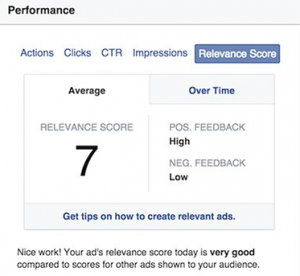Facebook has yet again taken a step to improve and refine the ads we see in our Facebook News Feeds. Welcome: Relevance scores.
Relevance scores are given to an ad and receive a rating from 1-10 with 10 being the most relevant to the business’s target audience. This helps us marketers out by forcing us to think critically about the specific targeted audience we want to advertise to and ultimately makes the consumer happier by seeing advertisements that interest them. We don’t want to waste our time (and money) by advertising to an audience that couldn’t care less about our advertised product, so thanks Facebook!
These relevance scores are determined by positive and negative feedback from the ad’s desired audience. As your targeted, and not targeted audience provide feedback and interact with the ad the score is adjusted in real time, so you may see scores vary from day-to-day and week-to-week.
Facebook determines positive feedback on an ad as:
“A rating based on the number of times your audience took a desired action after seeing your ad, such as shared or liked it, or helped you achieve your objective, such as visiting your website. When positive feedback is high it means people are responding well to your ad.”
And negative feedback on an ad as:
“A rating based on the number of times your audience hid your ad or otherwise indicated a negative experience such as choosing not to see ads from you. When negative feedback is high it means people don’t want to see this ad.”
If you discover that your ad has a relevance score of 2/10, don’t panic! There are a couple of things to consider that can help your relevance score: If your targeted audience is very broad, such as men and women, ages 18-65, living in the United States, you are probably putting your ad in front of a lot people who do not care to see it. It is a good idea to think about who exactly is your target audience and what action you want them to take after seeing your ad.
If your product is lipstick and your company is based out of Denver, Colo. and you want women to buy the newest color, you may consider targeting women, ages 18-34, living in Denver, interested in makeup. You should also make your call to action clear by stating something like “Try our new color today!” By narrowing your targeted audience down and defining a clear call to action, you are guaranteeing that your ad is showing up in front of an audience that most likely care about lipstick and they clearly understand what action they should take.
In this day and age, if people can’t decipher the message in your ad within 1 second they keep scrolling and you’ve lost them – probably to an ad that is easier to understand. So target your audience, have a clear message and clear call-to-action and you will see better relevance scores and therefore better results.
To make things even more confusing, I’d like to point out that Facebook ads purchased through frequency or reach that are guaranteed for delivery are not impacted by relevance. If your sole desire is to get a specific message out and have that message reach as many people as possible, relevance scores are irrelevant!
